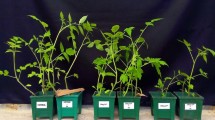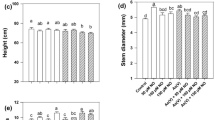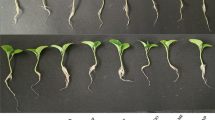Abstract
Tomato (Solanum lycopersicum L.) being a widespread and most commonly consumed vegetable all over the world has an important economic value for its producers and related food industries. It is a serious matter of concern as its production is affected by arsenic present in soil. So, the present study, investigated the toxicity of As(V) on photosynthetic performance along with nitrogen metabolism and its alleviation by exogenous application of nitrate. Plants were grown under natural conditions using soil spiked with 25 mg and 20 mM, As(V) and nitrate, respectively. Our results revealed that plant growth indices, photosynthetic pigments, and other major photosynthetic parameters like net photosynthetic rate and maximum quantum efficiency (F v /F m ) of photosystem II (PSII) were significantly (P ≤ 0.05) reduced under As(V) stress. However, nitrate application significantly (P ≤ 0.05) alleviated As(V) toxicity by improving the aforesaid plant responses and also restored the abnormal shape of guard cells. Nitrogen metabolism was assessed by studying the key nitrogen-metabolic enzymes. Exogenous nitrate revamped nitrogen metabolism through a major impact on activities of NR, NiR, GS and GOGAT enzymes and also enhanced the total nitrogen and NO content while malondialdehyde content, and membrane electrolytic leakage were remarkably reduced. Our study suggested that exogenous nitrate application could be considered as a cost effective approach in ameliorating As(V) toxicity.



Similar content being viewed by others
Abbreviations
- As(V):
-
Arsenic
- MDA:
-
Malondialdehyde
- A:
-
Net photosynthetic rate
- AAS:
-
Atomic absorption Spectroscopy
- SEM:
-
Scanning electron microscopy
- NO:
-
Nitric oxide
References
Abercrombie JM, Halfhill MD, Ranjan P, Rao MR, Saxton AM, Yuan JS, Stewart CN Jr (2008) Transcriptional responses of Arabidopsis thaliana plants to As (V) stress. BMC Plant Biol 8:87–101
APHA, AWWA, WEF (2005) Standard methods for the examination of water and wastewater. 21st edn. Washington, DC
Barabasz A, Kramer U, Hanikenne M, Rudzka J, Antosiewicz DM (2010) Metal accumulation in tobacco expressing Arabidopsis halleri metal hyperaccumulation gene depends on external supply. J Exp Bot 61:3057–3067
Bradford MM (1976) Rapid and sensitive method for the quantitation of microgram quantities of protein utilizing the principle of protein-dye binding. Anal Biochem 72:248–254
Carbonell AA, Burló F, López E, Mataix J (2008) Tomato plant nutrition as affected by arsenite concentration. J Plant Nutr 21:235–244
Ciszewski A, Milczarek G (2003) Electrochemical detection of nitric oxide using polymer modified electrodes. Talanta 61:11–26
Cornah JE, Terry MJ, Smith AG (2003) Green or red: what stops the traffic in the tetrapyrrole pathway? Trends Plant Sci 8:224–230
Desikan R, Griffiths R, Hancock J, Neill S (2002) A new role for an old enzyme: nitrate reductase mediated nitric oxide generation is required for abscisic acid-induced stomatal closure in Arabidopsis thaliana. PNAS 99:16314–16318
Dong Y, Xu L, Wang Q, Fan Z, Kong J, Bai X (2014) Effects of exogenous nitric oxide on photosynthesis, antioxidative ability, and mineral element contents of perennial ryegrass under copper stress. J Plant Interact 9:402–411
Finnegan PM, Chen W (2012) Arsenic toxicity: the effects on plant metabolism. Front Physiol 3:1–18
Gill SS, Tuteja N (2010) Reactive oxygen species and antioxidant machinery in abiotic stress tolerance in crop plants. Plant Physiol Biochem 48:909–930
Guo Z, Tan J, Zhuo C, Wang C, **ang B, Wang Z (2014) Abscisic acid, H2O2 and nitric oxide interactions mediated cold-induced S-adenosylmethionine synthetase in Medicago sativa subsp. Falcata that confers cold tolerance through up-regulating polyamine oxidation. Plant Biotechnol J 12:601–612
Heath RL, Packer L (1968) Photoperoxidation in isolated chloroplast. Part 1. Kinetics and stoichiometry of fatty acid peroxidation. Arch Biochem Biophys 1(25):189–198
Hiscox JD, Israelstam GF (1979) A method for the extraction of chlorophyll from leaf tissue without maceration. Can J Bot 57:1332–1334
Iqbal N, Umar S, Khan NA (2015) Nitrogen availability regulates proline and ethylene production and alleviates salinity stress in mustard (Brassica juncea). J Plant Physiol 178:84–91
Journet EP, Bligny R, Douce R (1986) Biochemical changes during sucrose deprivation in higher plant cells. J Biol Chem 261:3193–3199
Kumar S, Dubey RS, Tripathi RD, Chakrabarty D, Trivedi PK (2015) Omics and biotechnology of arsenic stress and detoxification in plants: current updates and prospective. Environ Int 74:221–230
Li WX, Chen TB, Huang Z, Lei M, Liao XY (2006) Effect of arsenic on chloroplast ultrastructure and calcium distribution in arsenic hyperaccumulator Pteris vittata L. Chemosphere 62:803–809
Lindner RC (1944) Rapid analytical methods for some of the more common inorganic constituents of plant tissues. Plant Physiol 19:76–89
Ma JF, Yamaji N, Mitani N, Xu XY, Su YH, McGrath SP, Zhao FJ (2008) Transporters of arsenite in rice and their role in arsenic accumulation in rice grain. PNAS USA 105:9931–9935
Mandal BK, Suzuki KT (2002) Arsenic round the world: a review. Talanta 58:201–235
Marmiroli M, Pigoni V, Savo-sardaro ML, Marmiroli N (2014) The effect of silicon on the uptake and translocation of arsenic in tomato (Solanum lycopersicum L.). Environ Exper Bot 99:9–17
Mascher R, Lippmann B, Holzinger S, Bergmann H (2002) Arsenate toxicity: effects on oxidative stress response molecules and enzymes in red clover plants. Plant Sci 163:961–969
Mobin M, Khan NA (2007) Photosynthetic activity, pigment composition and antioxidative response of two mustard (Brassica juncea) cultivars differing in photosynthetic capacity subjected to cadmium stress. J Plant Physiol 164:601–610
O’neal D, Joy KW (1973) Glutamine synthetase of pea leaves I purification, stabilization, and pH optima. Arch Biochem Biophys 1 69:113–122
Probst A, Liu H, Fanjul M, Liao B, Hollande E (2009) Response of Vicia faba L. to metal toxicity on mine tailing substrate: geochemical and morphological changes in leaf and root. Environ Exp Bot 66:297–308
Rachina MA, Nicholas DJD (1985) Glutamine synthetase and glutamate synthase from Sclerotinia sclerotiorum. Phytochemistry 24:2451–2548
Rinalducci S, Murgiano L, Zolla L (2008) Redox proteomics: basic principles and future perspectives for the detection of protein oxidation in plants. J Exp Bot 59:3781–3801
Ripullone F, Grassi G, Lauteri M, Borghetti M (2003) Photosynthesis-nitrogen relationships: interpretation of different patterns between Pseudotsuga menziesii and Populus× euroamericana in a mini-stand experiment. Tree Physiol 23:137–144
Rubinos D, Iglesias L, Devesa-rey Diaz-fierros F, Barral MT (2010) Arsenic release from river sediments in a gold-mining area (Anllons River basin, Spain): effect of time, pH and phosphorous concentration. Eur J Miner 22:665–678
Sanderson GW, Cocking EC (1964) Enzymic assimilation of nitrate in tomato plants. I. Reduction of nitrate to nitrite. Plant Physiol 39:416–422
Sengupta S, Shaila MS, Rao GR (1996) Purification and characterization of assimilatory nitrite reductase from Candida utilis. Biochem J 31:147–155
Sharma SS, Dietz K (2008) The relationship between metal toxicity and cellular redox imbalance. Trends Plant Sci 14:43–50
Singh AP, Dixit G, Kumar A, Mishra S, Singh PK, Dwivedi S, Trivedi PK, Chakrabarty D, Mallick S, Pandey V, Dhankher OP, Tripathi RD (2016) Nitric oxide alleviated arsenic toxicity by modulation of antioxidants and thiol metabolism in rice (Oryza sativaL.). Front Plant Sci. doi:10.3389/fpls.2015.01272
Stitt M, Muller C, Matt P, Gibon Y, Carillo P, Morcuende R, Scheible W, Krapp A (2002) Steps towards an integrated view of nitrogen metabolism. J Exp Bot 53:959–970
Stoeva N, Berova M, Zlatev Z (2005) Effect of arsenic on some physiological parameters in bean plants. Biol Plantarum 49:293–296
Stohr C, Stremlau S (2005) Formation and possible roles of nitric oxide in plant roots. J Exp Bot 57:463–470
Talukdar D (2013) Arsenic-induced oxidative stress in the common bean legume, Phaseolus vulgaris L. seedlings and its amelioration by exogenous nitric oxide. Physiol Mol Biol Plants 19:69–79
Yuan L, Shu S, Sun J, Guo S, Tezuka T (2012) Effects of 24 epibrassinolide on the photosynthetic characteristics, antioxidant system, and chloroplast ultrastructure in Cucumis sativus L. under Ca (NO3)2 stress. Photosynth Res 112:205–214
Acknowledgments
C. S. Seth thankfully acknowledged to University of Delhi for providing the Research and Development Grant vide letter no. RC/2014/6820 and DST-PURSE Grant vide letter no. RC/2014/7114 for performing the present work. Ashish Agnihotri is grateful to CSIR, New Delhi for awarding Junior Research Fellowship (JRF). Central Instrument Facility, Department of Botany, University of Delhi is sincerely acknowledged for providing all the required facilities.
Author information
Authors and Affiliations
Corresponding author
Rights and permissions
About this article
Cite this article
Agnihotri, A., Seth, C.S. Exogenously applied nitrate improves the photosynthetic performance and nitrogen metabolism in tomato (Solanum lycopersicum L. cv Pusa Rohini) under arsenic (V) toxicity. Physiol Mol Biol Plants 22, 341–349 (2016). https://doi.org/10.1007/s12298-016-0370-2
Received:
Revised:
Accepted:
Published:
Issue Date:
DOI: https://doi.org/10.1007/s12298-016-0370-2




